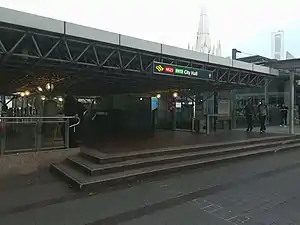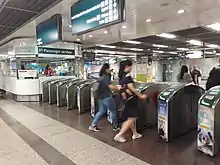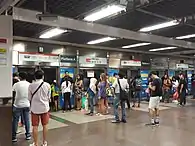City Hall MRT station
City Hall MRT station is an underground Mass Rapid Transit (MRT) interchange station on the North South (NSL) and East West Lines (EWL) in the Downtown Core district of Singapore. It is located underneath Stamford Road, at the junctions with North Bridge Road and St Andrew’s Road. The station is situated near City Hall (after which the station is named after), Raffles City, the Padang, St Andrew's Cathedral and The Cenotaph.
NS25 EW13
City Hall 政府大厦 நகர மண்டபம் City Hall | ||||||||||||||||
|---|---|---|---|---|---|---|---|---|---|---|---|---|---|---|---|---|
| Mass Rapid Transit (MRT) station | ||||||||||||||||
 Exit B of City Hall MRT station with St Andrew's Cathedral in the background. | ||||||||||||||||
| Location | 150 North Bridge Road Singapore 179100 | |||||||||||||||
| Coordinates | 1°17′35.66″N 103°51′7.99″E | |||||||||||||||
| Operated by | ||||||||||||||||
| Line(s) | ||||||||||||||||
| Platforms | 4 (2 island platforms) | |||||||||||||||
| Tracks | 4 | |||||||||||||||
| Connections | CC3 Esplanade | |||||||||||||||
| Construction | ||||||||||||||||
| Structure type | Underground | |||||||||||||||
| Platform levels | 2 | |||||||||||||||
| Parking | Yes (Raffles City) | |||||||||||||||
| Bicycle facilities | No | |||||||||||||||
| Disabled access | Yes | |||||||||||||||
| History | ||||||||||||||||
| Opened | 12 December 1987 | |||||||||||||||
| Electrified | Yes | |||||||||||||||
| Previous names | St. Andrew's[1][2] | |||||||||||||||
| Services | ||||||||||||||||
| ||||||||||||||||
| Location | ||||||||||||||||
_map.svg.png.webp) City Hall City Hall station in Singapore | ||||||||||||||||
The station is one of the earliest stations to be opened on the network, opening on 12 December 1987 when the North South line extended from Toa Payoh to Outram Park station. Cross-platform transfers between the NSL and EWL began on 4 November 1989 when the MRT network split operationally after the completion of the eastern line extension to Tanah Merah station. Due to its location at the heart of the Civic District and the numerous landmarks within its vicinity, City Hall station is one of the busiest MRT stations in Singapore.
History

The station was initially named St Andrew's before the construction of the station. It was later renamed to City Hall for historical reasons in 1982.[1][2] Contract 107B for the construction of City Hall station was awarded to Nishimatsu-Lum Chang Joint Venture at a contract sum of S$77.7 million (US$46.43 million) in May 1984.[3][4][5][6][7] A launching ceremony for the construction of the station was held on 7 September 1984. Largely a Christian ceremony, the gathering prayed for the safety of the construction workers, the successful completion of the station, the safety of the Cathedral and blessings for those using the station.[8]
The construction of the tunnels between the City Hall and Raffles Place stations was difficult as it has to go underneath the Singapore River, which was still polluted at the time and made the soil acidic. An integral waterproofing system was then implemented for the tunnel, as the system is not to be affected by the acidic soil condition and should be an effective and fast system to avoid delay due to tidal condition.[9] Parts of the Singapore River had to be "drained" in stages to facilitate the construction of the MRT tunnels. A cofferdam made of sheet-piles was used to drain the river to allow the construction using the cut-and-cover method in stages.[10] The construction was done in two stages: 20 metres (66 ft) from the riverbank at the Immigration Department site and the remaining 70 metres (230 ft) at the other side.[11]
The station opened on 12 December 1987,[12] and later became an interchange station between the East West and North South lines after the operational split on 4 November 1989.[13][14][15][16]
Plans were announced by the Land Transport Authority (LTA) to construct a new underpass between the station and the redeveloped Capitol Singapore. Construction work on the underground link and the new station entrance started in the fourth quarter of 2014, and completed in the first quarter of 2015.[17][18]
Incidents
During the construction, on 26 May 1985, there was a landslide at the site due to the collapse of the 20-metre (66 ft) wall supporting the excavation. Those in the nearby St Andrew's Cathedral were evacuated as a safety precaution, as the Cathedral may risk collapse.[19] The Cathedral was eventually declared safe for use and operations resumed on 2 June, while advising churchgoers not the use the half of the Cathedral close to the site.[20] On 10 December, a Japanese foreman miner died at the construction site of the station, having fallen to his death. The man is the fourth fatality in the construction of the MRT network.[21][22] Investigations revealed that it was entirely an accident, with all safety measures observed.[23]
On 5 June 2008, 280 youths spent the night at City Hall to learn how to deal with an emergency in a train tunnel. There was a simulated bomb explosion during this exercise and they learn how to activate the detrainment ramps at both ends of the train, and evacuate to safety via an escape shaft. The students also used the items from their Ready Bags to "survive" the attack.[24]
This station was part of the series of 2011 MRT train disruptions on 15 and 17 December 2011, caused by a misalignment between the trains' current collector shoes, which collect power from the third rail, and the third rail itself. These were Singapore's two largest MRT disruptions at the time of occurrence.[25][26][27][28]
A power failure and blackout occurred at the station on 6 July 2012 at about 1.30 pm, causing the platforms for north and west-bound trains to turn pitch black. Air-conditioning and escalators also stopped functioning. Emergency lighting was turned on immediately after the incident occurred. However, train services were not affected by the incident.[29] Lighting was progressively restored from 2 pm, and was back to normal by 3.15 pm.[30]
Station details
Services
Track layout | ||||||||||||||||||||||||||||||||||||||||||||||||||||||||||||||||||||||
|---|---|---|---|---|---|---|---|---|---|---|---|---|---|---|---|---|---|---|---|---|---|---|---|---|---|---|---|---|---|---|---|---|---|---|---|---|---|---|---|---|---|---|---|---|---|---|---|---|---|---|---|---|---|---|---|---|---|---|---|---|---|---|---|---|---|---|---|---|---|---|
Upper level (B2) | ||||||||||||||||||||||||||||||||||||||||||||||||||||||||||||||||||||||
| ||||||||||||||||||||||||||||||||||||||||||||||||||||||||||||||||||||||
Lower level (B3) | ||||||||||||||||||||||||||||||||||||||||||||||||||||||||||||||||||||||
| ||||||||||||||||||||||||||||||||||||||||||||||||||||||||||||||||||||||
The station has three levels with two levels of island platforms.[8][31] City Hall is one of the two paired cross-platform interchanges between the East West and North South lines. On the EWL, the station is after Bugis, while on the NSL it is after Dhoby Ghaut station. Both lines continue and interchange at Raffles Place station. The station code is EW13 NS25, as reflected on official maps.[32]
Before the eastern extension to Tanah Merah station and the Marina Bay southern extension on 4 November 1989, there were through services from the Yishun to Lakeside stations. A few days before the opening, on 28 October, transfer drills were launched for commuters to familiarise with transferring between the two services: with passengers from Yishun having to alight at either Raffles Place or City Hall to continue their journey to Lakeside or vice versa.[33] MRTC (Mass Rapid Transit Corporation) staff were stationed at the platforms to help commuters, in addition to MRTC and SMRT's advertisement campaigns about the transfers.[34]
Places of Interest
See also
References
- "New names for eight stations". Singapore Monitor. 30 November 1982.
- "Station names will reflect their localities". The Straits Times. 30 November 1982. p. 7.
- "Japanese win MRT awards". The Business Times. 5 May 1984. Archived from the original on 23 August 2020. Retrieved 23 August 2020.
- "Mass Rapid Transit Corporation Contract 107B City Hall Station | dedicated to Project Controls". www.planningplanet.com. Archived from the original on 13 April 2020. Retrieved 13 April 2020.
- "Lum Chang - Civil & Infrastructure". www.lumchang.com.sg. Archived from the original on 13 April 2020. Retrieved 13 April 2020.
- "Better offer and skills win MRT deals for 2 firms". Singapore Monitor. 7 September 1984. Archived from the original on 23 August 2020. Retrieved 23 August 2020.
- "More MRT work going to local companies". The Business Times. 12 November 1985. Archived from the original on 23 August 2020. Retrieved 23 August 2020.
- "A prayer for the City Hall MRT station". The Straits Times. 8 September 1984. p. 12.
- Outline of Cementaid HPI Used In Singapore's Mass Rapid Transit Railways. Cementaid. p. 7.
- "Singapore River to be 'drained' for MRT job". Business Times. 13 March 1984. p. 1.
- "MRT 'river crossing' easier than expected". The Straits Times. 26 April 1985. p. 11.
- Rav, Dhaliwal (12 December 1987). "Shopping for Xmas the MRT way..." The Straits Times. Archived from the original on 24 January 2018. Retrieved 19 September 2017 – via eResources.
- "MRT eastern line to start operating on Nov 18". The Business Times. 4 August 1989. Archived from the original on 23 August 2020.
- "On right track". The Straits Times. 4 November 1989. Archived from the original on 23 August 2020.
- Dhaliwal, Rav (5 November 1986). "MRT Trains to Pasir Ris from Dec 16". The Straits Times. Archived from the original on 23 August 2020.
- "18 mins from City Hall to Tanah Merah by MRT from Nov 4". The Straits Times. 15 October 1984. Archived from the original on 23 August 2020. Retrieved 23 August 2020.
- "Underpass to link City Hall MRT and Capitol Singapore". Today. 27 May 2014. Archived from the original on 13 April 2020.
- "News Room - News Releases - Better Pedestrian Connectivity from City Hall MRT Station". LTA. 27 May 2014. Archived from the original on 23 August 2020. Retrieved 23 August 2020.
- "Surprise cathedral clearance causes no alarm". The Straits Times. 27 May 1985.
- "Cathedral is safe for use". The Straits Times. 1 June 1985.
- "Foreman died at City Hall MRT Station". The Business Times. 10 December 1985. Archived from the original on 5 October 2017. Retrieved 5 October 2017.
- "Foreman dies after fall at MRT worksite". 10 December 1985. Retrieved 23 August 2020.
- "Japanese tunnel supervisor's death fall: It's misadventure". The Straits Times. 24 September 1987. Retrieved 23 August 2020.
- "280 youths take part in emergency exercise in MRT tunnel". Channel NewsAsia. 6 June 2008. Archived from the original on 16 February 2010. Retrieved 6 June 2008.
- Low, Ignatius (16 December 2011). "Singapore's MRT Breakdown Chaos Leaves Thousands Stranded". The Straits Times. Archived from the original on 7 January 2012. Retrieved 3 November 2012.
- "MRT breaks down again". Channel NewsAsia. 17 December 2011. Archived from the original on 7 January 2012. Retrieved 15 February 2013.
- "North-South Line service resumes after 7-hour disruption". Channel NewsAsia. 17 December 2011. Archived from the original on 7 January 2012. Retrieved 15 February 2013.
- "Service disruption on North-South Line on 17 Dec 2011" (PDF). Archived from the original (PDF) on 14 April 2012.
- "Power blackout at City Hall MRT station". Channel NewsAsia. 6 July 2012. Archived from the original on 7 July 2012. Retrieved 7 July 2012.
- "City Hall MRT lights, escalators back on after blackout". Channel NewsAsia. 6 July 2012. Archived from the original on 7 July 2012. Retrieved 6 July 2012.
- "Three-level station for City Hall Station". Singapore Monitor. 30 November 1982. p. 43.
- "MRT System Map" (PDF). Land Transport Authority (LTA). Retrieved 23 August 2020.
- "MRT transfers will begin this Saturday". The Straits Times. 24 October 1989. p. 3.
- "MRT transfers drill off to smooth start". The Straits Times. 29 October 1989. p. 21.
- "$2m worth of artworks for six MRT stations". Business Times. 5 December 1987.
- "$2m worth of art for six MRT stations". The Straits Times. 5 December 1987.
- "Singapore". World of Monopoly.com. 4 May 2013. Archived from the original on 18 February 2020. Retrieved 19 June 2020.
External links
 Media related to City Hall MRT Station at Wikimedia Commons
Media related to City Hall MRT Station at Wikimedia Commons- Official website
- Changi Airport to City Hall MRT station route

